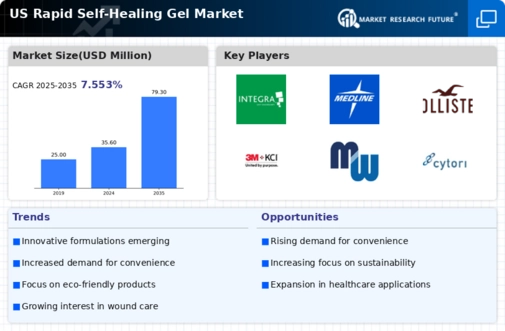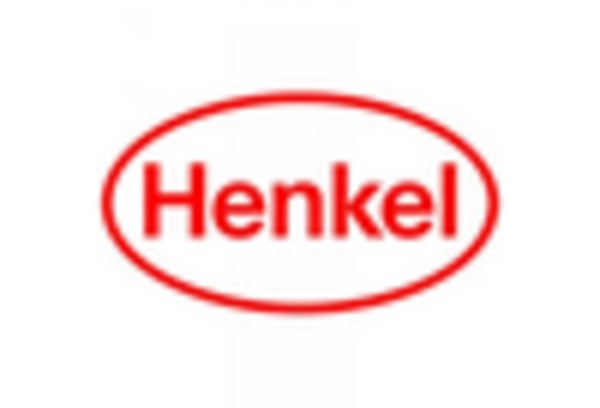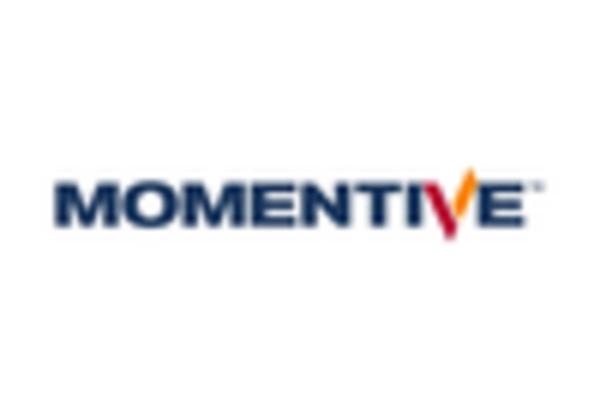Rising Consumer Awareness
Consumer awareness regarding the benefits of self-healing technologies is on the rise, significantly impacting the rapid self-healing-gel market. As consumers become more informed about the advantages of using self-healing materials, such as reduced maintenance and increased product lifespan, demand is expected to grow. This shift in consumer behavior is particularly evident in sectors like construction and consumer electronics, where durability is a key purchasing factor. Market Research Future indicates that approximately 60% of consumers are willing to pay a premium for products that incorporate self-healing technologies. This growing preference is likely to drive manufacturers to adopt self-healing gels in their products, thereby expanding the market.
Increased Investment in R&D
Investment in research and development (R&D) is a critical driver for the rapid self-healing-gel market. Companies are allocating substantial resources to explore new formulations and applications of self-healing gels, aiming to enhance their properties and performance. This focus on innovation is evident in the increasing number of patents filed in the field, which indicates a robust interest in developing novel self-healing solutions. The U.S. government has also recognized the potential of self-healing technologies, providing funding for projects that aim to advance this field. As a result, the rapid self-healing-gel market is likely to benefit from breakthroughs in material science, leading to improved products and expanded market opportunities.
Expansion of Application Sectors
The rapid self-healing-gel market is witnessing an expansion of application sectors, which is a significant driver of growth. Industries such as healthcare, automotive, and electronics are increasingly exploring the use of self-healing gels for various applications, including wound healing, protective coatings, and flexible electronics. This diversification is driven by the unique properties of self-healing gels, which offer solutions to challenges faced in traditional materials. For instance, in the healthcare sector, self-healing gels are being developed for use in advanced wound dressings, which can enhance healing processes. As more sectors recognize the potential benefits of self-healing technologies, the market is likely to experience robust growth, with new applications emerging regularly.
Growing Demand for Advanced Materials
The rapid self-healing gel market is experiencing a surge in demand for advanced materials that can enhance product durability and longevity. Industries such as automotive, aerospace, and electronics are increasingly adopting self-healing technologies to improve the performance of their products. This trend is driven by the need for materials that can withstand wear and tear, thereby reducing maintenance costs. According to recent estimates, the market for advanced materials is projected to grow at a CAGR of approximately 10% over the next five years. As manufacturers seek to innovate and differentiate their offerings, the integration of self-healing gels into various applications is likely to become a key focus area, further propelling the growth of the rapid self-healing-gel market.
Regulatory Support for Innovative Materials
Regulatory bodies in the U.S. are increasingly supporting the development and commercialization of innovative materials, including self-healing gels. This support is manifested through grants, subsidies, and favorable policies aimed at promoting advanced manufacturing technologies. The rapid self-healing-gel market stands to benefit from these initiatives, as they encourage companies to invest in the development of sustainable and efficient materials. Furthermore, regulations that mandate higher performance standards in various industries are likely to drive the adoption of self-healing technologies. As a result, the market is expected to witness accelerated growth, fueled by both regulatory incentives and the need for compliance with evolving industry standards.

















Leave a Comment